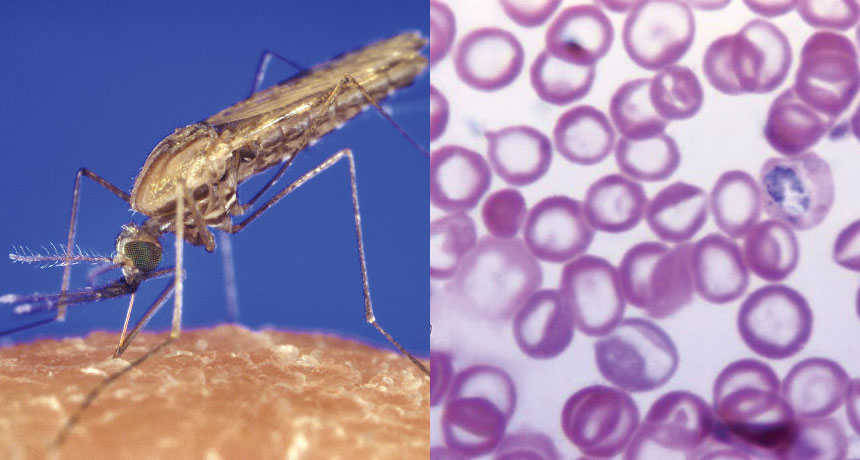Malaria parasites lure mosquitoes to infected hosts
Parasites make blood smell appealing so that mosquitoes will be drawn to sip it

The malaria parasite (right) produces a molecule known as HMBPP. When mixed with red blood cells, HMBPP helps lure Anopheles gambiae mosquitoes (left) to infected blood.
From left: James Gathany/CDC; Steven Glenn/Laboratory & Consultation Division/CDC
A microbe that causes malaria tricks mosquitos into helping it spread, a new study finds. The microbe is a parasite that leaves a chemical behind in the blood of the people or other animals that it infects. Mosquitoes are drawn to scent of blood hosting this chemical. It entices them to slurp up some of the infected meal. Then voila! The parasites get airlifted from their old host to new ones. And so malaria spreads.
The new study offers an “intriguing glimpse” into how the parasite manipulates the blood-suckers into fostering its spread, says Conor McMeniman. He’s a mosquito researcher at Johns Hopkins University in Baltimore, Md. He was not involved in the study.
Malaria is a serious illness. Its symptoms include fevers, chills, head and body aches, nausea and tiredness. Some people get recurring bouts of these symptoms for decades. And in young children, the disease can prove deadly.
A few mosquito species in the genus Anopheles (Ah-NAH-ful-ees) can spread malaria. They bite people in warm regions of the world, especially in Africa, South Asia and parts of Central and South America. If the insects that sip their blood had previously dined on the blood of people (or animals) already infected with malaria, the mosquito can transmit some of those disease-causing parasites.
The parasite in the new research is called Plasmodium falciparum (Plaz-MOH-dee-um Faal-SIH-puh-rum). It’s one of several single-celled microbes that cause malaria in people. And it’s the one that most often causes a severe form of the disease.
Previous research had hinted that mosquitoes seemed to target people already sick with malaria. But it was not clear why. This prompted a research team led by Noushin Emami to look into it. She’s a biologist at Stockholm University in Sweden. Her group got an unexpected tip off while studying a molecule known as HMBPP. They were studying how the molecule affects the immune system of Anopheles gambiae. These mosquitoes are a major means of transmitting malaria. And P. falciparum releases this molecule into the blood of its animal hosts.
The researchers watched mosquitoes sip blood from artificial feeders. “The mosquitoes ate a lot more,” notes Ingrid Faye, “when the HMBPP was in the blood.” Faye also works at Stockholm University. That observation, she explains, “made us think [the molecule] changes [the mosquito’s] behavior.”
HMBPP didn’t directly lure the mosquitoes. The researchers learned that when they tried mixing it with serum. That’s the watery part of blood that’s left behind when red blood cells are removed. HMBPP-laced serum just didn’t interest the mosquitoes nearly as much. But it was a different story when they added this chemical to red blood cells. These cells now released more carbon dioxide than usual. That’s a gas that people exhale.
The researchers also found that adding HMBPP to red cells led the blood to release more airborne chemicals called aldehydes (AL-duh-hides) and monoterpenes. These compounds also are released by plants. And the scent of these chemicals lures in more mosquitoes. The insects drank a bigger blood meal than normal when the blood had released all of these gases.
The team reported its results online February 9 in Science.
The new data make sense. Carbon dioxide is a gas that helps mosquitoes track down their mammal meal tickets — including people. And aldehydes and monoterpenes might attract mosquitoes by making people smell a bit like the plants from which these insects also get some nectar, says McMeniman at Johns Hopkins. He cautions, however, that HMPBB’s effect was tested, to date, only in artificial mosquito feeders. That means it’s still unclear how strongly it would lure mosquitoes to infected people.







